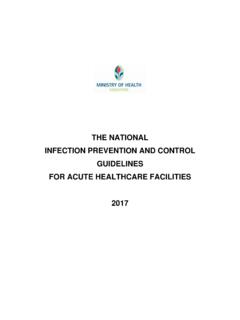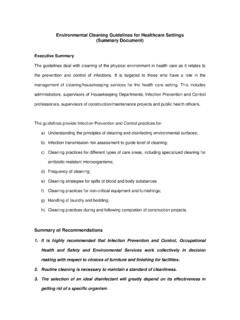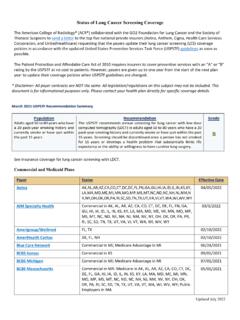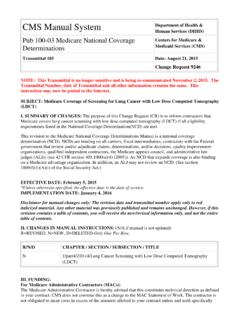Transcription of Cancer Screening MOH 140510
1 MOH Clinical Practice Guidelines 1/2010 Cancer ScreeningFeb 2010 Ministry of Health, SingaporeCollege of Medicine Building16 College RoadSingapore 169854 TEL (65) 6325 9220 FAX (65) 6224 1677 WEB of Family Physicians, SingaporeISBN 978-981-08-5215-3 Chapter of Respiratory Physicians, Chapter of Medical Oncologists, College of Physicians, SingaporeAcademy of Medicine, SingaporeLevelsofevidenceandgradesofreco mmendationLevelsofevidenceLevelTypeofEvi dence1++Highqualitymeta-analyses,systema ticreviewsofrandomisedcontrolledtrials(R CTs), +Wellconductedmeta-analyses,systematicre viewsofRCTs, ,systematicreviewsofRCTs,orRCTswithahigh riskofbias2++ +Wellconductedcasecontrolorcohortstudies withalowriskofconfoundingorbiasandamoder ateprobabilitythattherelationshipiscausa l2-Casecontrolorcohortstudieswithahighri skofconfoundingorbiasandasignificantrisk thattherelationshipisnotcausal3 Non-analyticstudies, casereports, caseseries4 ExpertopinionGradesofrecommendationGrade RecommendationAAtleastonemeta-analysis,s ystematicreviewofRCTs,orRCTratedas1++and directlyapplicable to the targetpopulation.
2 OrAbodyofevidenceconsistingprincipallyof studiesratedas1+,directlyapplicabletothe targetpopulation,anddemonstratingoverall consistency of resultsBAbodyofevidenceincludingstudiesr atedas2++,directlyapplicabletothetargetp opulation,anddemonstratingoverallconsist encyofresults; orExtrapolatedevidencefromstudiesratedas 1++or1+CAbodyofevidenceincludingstudiesr atedas2+,directlyapplicabletothetargetpo pulationanddemonstratingoverallconsisten cy ofresults; orExtrapolatedevidencefromstudiesratedas 2++DEvidencelevel3or4;orExtrapolatedevid encefromstudiesratedas2+GPP(goodpractice points) of evidence and grades of recommendationLevelType of EvidenceGradeRecommendationCLINICAL PRACTICE GUIDELINESC ancer ScreeningMOH Clinical Practice Guidelines 1/2010 Published by Ministry of Health, Singapore16 College Road,College of Medicine BuildingSingapore 169854 Printed byGolden City Colour Printing Co.
3 (Pte) LtdCopyright 2010 by Ministry of Health, SingaporeISBN978-981-08-5215-3 Available on the MOH website: of IntentThese guidelines are not intended to serve as a standard of medical standards are determined on the basis of all clinical data available foran individual case and are subject to change as scientific knowledgeadvances and patterns of care contents of this publication are guidelines for clinical practice, basedon the best available evidence at the time of development. Adherence tothese guidelines may not ensure a successful outcome in every case. Theseguidelines should neither be construed as including all proper methods ofcare, nor exclude other acceptable methods of care.
4 Each physician isultimately responsible for the management of his/her unique patient, in thelight of the clinical data presented by the patient and the diagnostic andtreatment options of IntentContentsPageExecutive summary of recommendations15noitcudortnI12 Screening for Nasopharyngeal Carcinoma1161recnaClatceroloCrofgnineerc S303recnaCreviLrofgnineercS443recnaCgnuL rofgnineercS56 Screening for Breast Cancer in Women3725recnaClacivreCrofgnineercS795re cnaCeniretUrofgnineercS826recnaCnairavOr ofgnineercS966recnaCetatsorProfgnineercS 0187tnemevorpmIytilauQlacinilC1197secner efeR401)sQCM(tnemssessa-fleS701srebmeMpu orgkroWForewordCancer is the leading cause of mortality in Singapore, accounting forapproximately 28% of the total number of deaths.
5 Colorectal Cancer (Age-standardised rate, ASR per 100 000 per year) and breast Cancer (ASR 100 000 per year) are the most common cancers among males and femalesrespectively. Guidance on Cancer Screening was previously covered in theMOH clinical practice guidelines (CPG) on Health Screening published in2003. As Cancer has consistently been a major disease burden, it is appropriatethat the updated guidelines are published as a dedicated CPG on Screening aims to detect disease early in asymptomatic people throughthe application of examinations or procedures. With the proliferation of cancerscreening packages and types of Screening tests in the market, there is a needfor evidence-based guidelines to help doctors in selecting the appropriate testsfor their patients.
6 Screening is not without risks. False positives inevitablygenerate anxiety and require further tests that introduce additional risks andcosts; false negatives may confer a false sense of security. Screening shouldonly be conducted when supported by evidence of improved clinical outcomewhen a condition is discovered and treated at an earlier stage than waspreviously the revisions/additions to the previous health Screening CPG include a newchapter on Screening for nasopharyngeal carcinoma. This CPG also takes intoaccount new evidence and their impact on Cancer Screening . For example, newrecommendations concerning cervical Cancer Screening for HPV-vaccinatedwomen and the use of computed tomography colonography in colorectal cancerscreening have been included in this hope that this publication will assist doctors and patients make appropriatedecisions in Screening for K SATKUDIRECTOR OF MEDICAL SERVICES1 Executive summary of key recommendationsThis executive summary contains the key recommendations from the maintext of the guidelines.
7 Please refer to the main text for fornasopharyngeal carcinomaBMass Screening of general population at normal risk with EBV serologyisnot recommended (pg 13).Grade B, Level 2++ Screening for colorectal cancerAFor average-risk individuals, Screening for colorectal Cancer has beenshown to improve survival and is recommended (pg 18).Grade A, Level 1++BFor average-risk individuals, Screening for colorectal Cancer shouldbegin at age 50 years (pg 18).Grade B, Level 2++BFor individuals at increased risk or high risk, Screening bycolonoscopy is indicated. (Refer to table 1 for age at which screeningshould be started) (pg 18).
8 Grade B, Level 2++ Screening for liver cancerC Patients with chronic hepatitis B infection and liver cirrhosis from otheretiologies are at increased risk of developing hepatocellular carcinoma,and surveillance should be offered to these at-risk individuals with the aimof detecting hepatocellular carcinoma that could be more amenable totherapy, and hence potentially translate to better outcomes (pg 31).Grade C, Level 2+Executive summary of key recommendationsBABBC2 Screening for lung cancerA The use of serial chest X-rays to screen for lung Cancer is notrecommended (pg 35).Grade A Level 1+A The use of single or serial sputum cytologic evaluation to screen forlung Cancer is not recommended (pg 35).
9 Grade A, Level 1+C The use of low- dose CT scan to screen for lung Cancer outside thecontext of a clinical trial is not recommended (pg 35).Grade C, Level 2+ Screening for breastcancer in womenAAll normal risk, asymptomatic women 50-69 years of age should bescreened with mammography only, every two years. Ultrasound andclinical breast examination are not routinely required (pg 47).Grade A, Level l++CWomen at normal risk aged 40-49 years should be informed of thebenefits, limitations and potential harms associated with screeningmammography so that they can make an informed choice. If Screening isto be performed, it should be done annually.
10 Ultrasound and clinical breastexamination are not routinely required (pg 47).Grade C, Level 2++A Normal risk, asymptomatic women under 40 years should not undergobreast Screening with any imaging modality (pg 47).Grade A, Level l+AAACCA3A In Western nations, the evidence supports mammographic screeningevery 2 years for all normal risk women 70-75 years of age. However, forSingaporean women the lower incidence of breast Cancer in this age groupsuggests that Screening mammography may be less beneficial and shouldbe individualizedby considering the potential benefits and risks ofmammographyin the context of current health status and estimated individual Screening is performed, it should be at two-yearlyintervals.












